Columbia Horror from Indicator
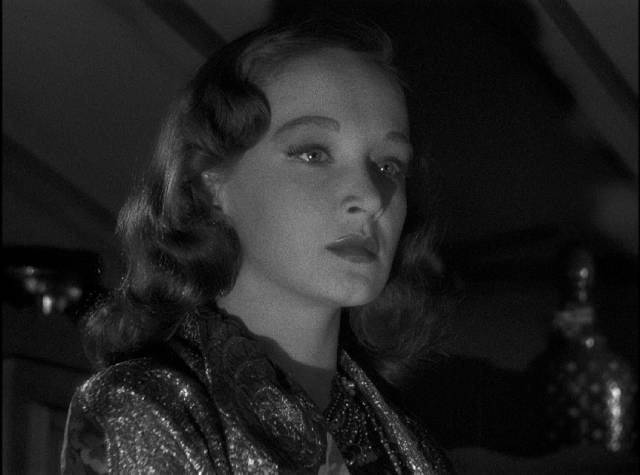
There’s something about box sets that appeals to me. Part of it has something to do with the impression that they’re a deal – you get so much more for your money. But it’s also because they often contain movies I might not have come across or bothered to buy if they’d been released on their own. Also, someone has curated them, putting together seemingly disparate titles which nonetheless have things in common. I do like to connect things, to see individual items as elements in a larger context, and box sets take care of a lot of the preliminary work of organizing.
In the early days of DVD, the big studios dug into their catalogue holdings and released numerous themed sets, often with a lot of contextual supplements to enhance their appeal and historical value. In time, as sales plateaued, there was a decline in this archival work, but more recently, with the licensing of those holdings to independent companies, there’s been a new surge in such releases. In England, Indicator and Eureka in particular have been scouring the vaults of Columbia and Universal for genre B-movies, predominantly horror and films noirs from the ’30s into the ’60s. Produced as disposable commercial products with little concern for any lasting value, many of these movies now have interest as time capsules – in their documentary value as glimpses of a time long past as well as a showcase for various cinematic techniques and storytelling styles.
Columbia Horror (Various, 1933-44)
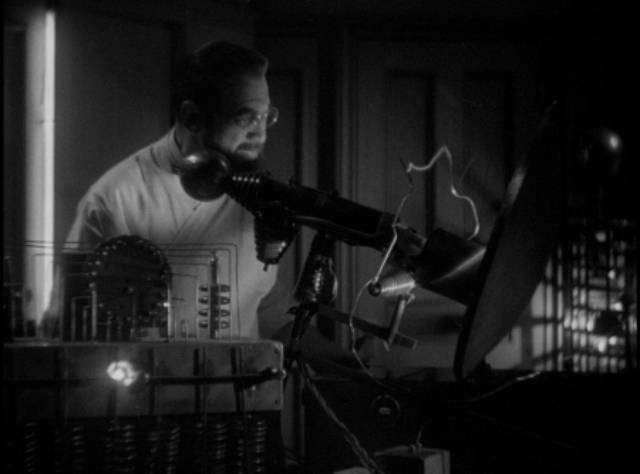
The latest set from Indicator collects six Columbia B-movies from the ’30s and ’40s, a period I definitely have a fondness for, and I was hoping for something like Eureka’s Karloff at Columbia set. But the title Columbia Horror turns out to be a bit of a misnomer since only three of the six movies can honestly be called horror, even if some of the others contain occasional nasty elements. Despite the presence of Boris Karloff in a supporting role (a year after Frankenstein), John Francis Dillon’s Behind the Mask is a crime story. Albert S. Rogell’s Air Hawks is an adventure movie with a sci-fi element, which is more akin to a matinee serial. And Charles Barton’s Island of Doomed Men is a mix of adventure and crime with a heavy dose of sadism thrown in. The three horror titles are Roy William Neill’s Black Moon, Henry Levin’s Cry of the Werewolf and Will Jason’s The Soul of a Monster.
Each of these six movies has interesting elements, though the quality of execution varies, and all are briskly paced at just over an hour each. I might have enjoyed them all more if I hadn’t been primed to expect some generic consistency – the movies in Eureka’s Columbia set and their various Universal horror sets are equally uneven, but at least they do all count as horror.
*
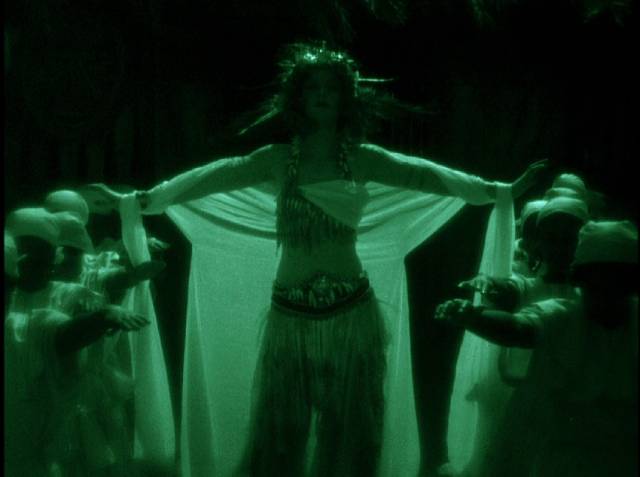
Black Moon (Roy William Neill, 1934)
That said, the most interesting movie in the Indicator set is Black Moon (1934), which comes two years after Victor Halperin’s White Zombie (1932) and almost a decade before Jacques Tourneur’s I Walked With a Zombie (1943), and it rests comfortably in the same world as those two better-known films. And like them, the spectre of race and the history of slavery casts a shadow over the narrative. Juanita Lane (Dorothy Perez) was born on the small Caribbean island of St. Christopher to a family of plantation owners and, while she was still a child, her parents were killed when the Black plantation workers rebelled. Now married to Stephen Lane (Jack Holt) in New York, with a young daughter, she is haunted by her past and given to banging on a native drum up in her daughter’s bedroom. It’s decided that she needs to go back to the island and reconnect with her past, so she heads out with daughter Nancy (Cora Sue Collins), the girl’s nanny Anna (Eleanor Wesselhoeft) and Stephen’s secretary Gail Hamilton (Fay Wray), while Stephen stays home to take care of his business.
On the island, Juanita is greeted by the “natives” (the film elides their actual status as the descendants of slaves kidnapped from Africa) not just enthusiastically, but with adoration. Despite her status as the daughter of the plantation owners, she was raised by a Black nurse and, in thematic terms, has been corrupted by that “primitive” influence; in fact it eventually turns out that she has been groomed from birth to serve as their Voodoo priestess. Her uncle Raymond (Arnold Korff) tries to warn her – and Gail – that it’s not safe on the island, but the grip of the Black religion is too strong. Anna is killed and Gail cables Stephen to come immediately. He arrives just in time to prevent Juanita from ritually sacrificing Nancy, decisively suppressing the Black influence on the family and paving the way for a reconstituted white family – himself, Gail and Nancy – to sail away back to “civilization”.
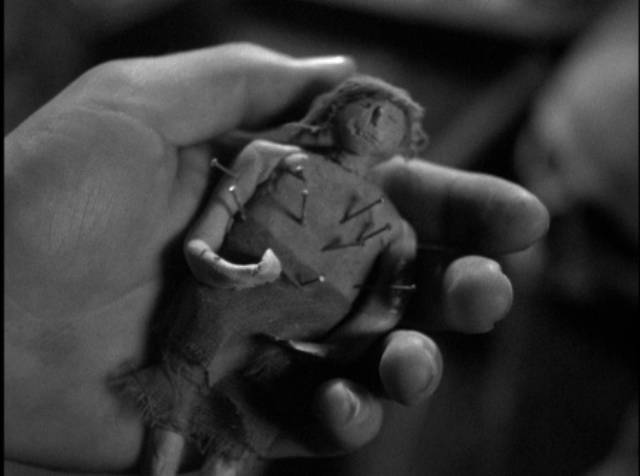
As is often the case in Hollywood movies which drift into the tricky waters of race, the role of white responsibility is papered over and the Black characters are presented as a dangerous threat to the stability of the dominant society. In fact, the common thread which runs through Black Moon, White Zombie and I Walked With a Zombie is the idea that the occult powers possessed by slaves (and former slaves) are capable of enslaving whites whose own (rational) powers are paradoxically much weaker. Hidden in this peculiar reversal of the actual history is the oppressors’ fear that the oppressed will eventually rise up and subject their former masters to the same subjugation they have suffered.
Even though dialogue explicitly refers to two-hundred years of the family’s rule over slaves on the plantation and repeated rebellions which have resulted in deaths in every generation (with no indication that there has ever been a transition from slavery to emancipation), the right of white ownership is never actually questioned, though the “contamination” of Juanita suggests that the end of white dominance is inevitable. But rather than seeing this as a natural and just progression, the movie’s ending sees the abandonment of the island by the white family and its descent into primitivism as the only possible outcome as Stephen, Gail and Nancy head back to the modern world of New York.
*
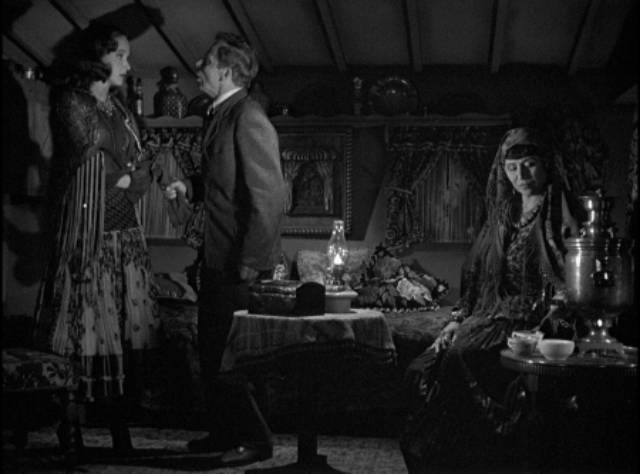
Cry of the Werewolf (Henry Levin, 1944)
Contaminated femininity is also at the heart of Cry of the Werewolf (1944), which was obviously influenced by Tourneur’s Cat People (1942). Gypsy princess Celeste LaTour (Nina Foch) bears the curse of her ancestors, which transforms her into a wolf at times (though as with Cat People’s Irena [Simone Simon], this is dictated by internal psychological pressures rather than the moon). Dr. Charles Morris (Fritz Leiber) runs a small museum in New Orleans dedicated to Celeste’s ancestor and as he prepares to publish a history of the family, he’s torn to pieces by an animal. His son Bob (Stephen Crane) arrives to investigate and falls under the spell of the princess, even though he should obviously become romantically involved with dad’s assistant Elsa (Osa Massen), who being foreign is initially suspected by police detective Barry Lane (Barton MacLane) of killing her boss.
With hidden passages, family secrets and old world occult influences, the movie has a creaky Old Dark House feeling. The most interesting aspect is Celeste’s torment about her condition, something over which she has no control and which makes her do terrible things against her will – like Larry Talbot in The Wolf Man (1941), she’s a sympathetic monster. Most of the cast is fine, though Stephen Crane is pretty awful (this was the first of only three credits). Cry of the Werewolf was Henry Levin’s first directing credit and, although he never rose above the level of journeyman, he did go on to do better work.
*
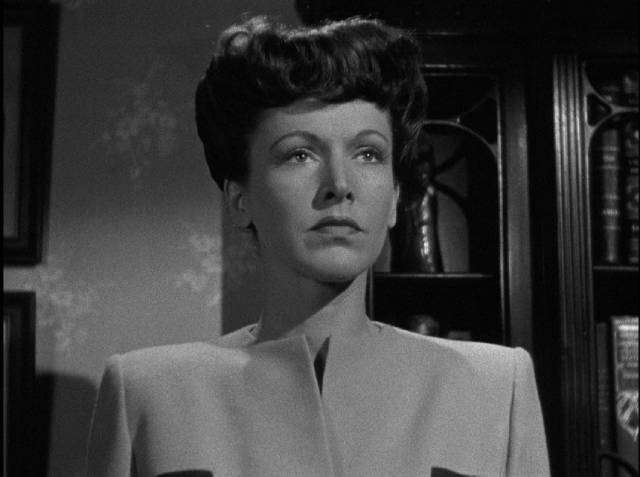
The Soul of a Monster (Will Jason, 1944)
The oddest movie in the set is The Soul of a Monster (1944), directed by someone named Will Jason, who had a prolific B-movie career from 1938 to the early ’50s before settling into episodic television for a decade. Despite a talky script by Edward Dein, the film has a strange tone which seems reminiscent of a dour Weimar silent movie steeped in 19th Century occultism, like Robert Reinert’s Nerves (1919), Arthur Robison’s Warning Shadows (1923) or Paul Leni’s Waxworks (1924). And yet despite a ponderous pace, there are some redemptive elements, not least the expressive cinematography of Burnett Guffey; although still early in his career, his work here already displays the visual skills he would soon bring to some classic films noirs. Also of interest is the cast, particularly the two female leads – Jeanne Bates, who three decades later would appear as Mrs. X in Eraserhead (1976), and Rose Hobart, whose busy career would be derailed by the Black List in the late-’40s.
The movie opens with a montage of newspapers and pieces of gossip which inform us that beloved philanthropic doctor George Winson (George Macready) is dying of some incurable illness. He’s watched over by his wife Ann (Bates) and his colleague Dr. Roger Vance (Jim Bannon), who has accepted that the case is hopeless. Ann desperately begs out loud to any power that might be listening, declaring that she’s willing to give anything to save her husband. At which point there’s an abrupt cut to a dark street suddenly lit by a shower of sparks from a downed power line. Out of the darkness, a woman walks through the sparks as the camera tilts to suggest the world has become unstable.
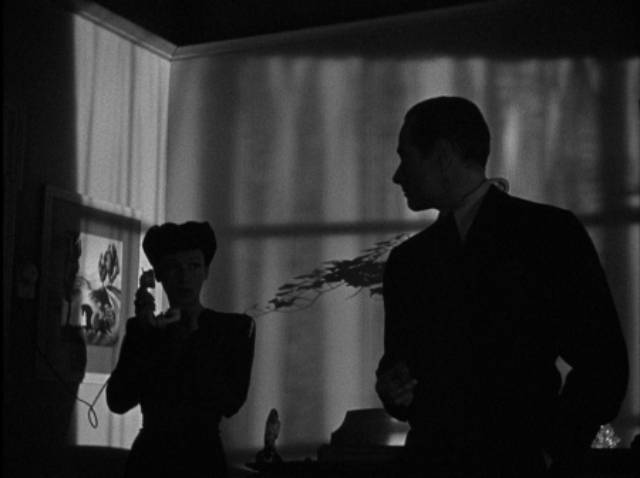
She arrives at the doctor’s house and immediately takes charge, sending everyone out of the room so she can work in private. Hours later, she emerges and apparently Winson is “cured”. But she doesn’t leave, becoming the doctor’s constant companion. There’s more for Ann and Dr. Vance to worry about, though, than this mysterious woman’s intrusive presence – Winson has changed. He’s now a cold, selfish man – literally cold – and when his wrist is inadvertently cut, he doesn’t bleed. Apparently he’s a walking dead man … the “deal” Ann offered in her original plea has kept her husband “alive” at the cost of his soul.
Whether Lilyan Gregg is the devil incarnate or merely one of his minions isn’t clear, but she has taken over Winson’s life and stripped away everything which made him admired and valued. George Macready does a good job as the soulless pawn and Rose Hobart plays Lilyan with chilly authority – and a rather alarming hairdo. As already mentioned, her very busy career, which began with Frank Borzage’s Liliom in 1930 and included Rouben Mamoulian’s Dr. Jekyll and Mr. Hyde (1931), was derailed in 1949 by the McCarthy witch hunt, only resuming in 1960 when she began to appear on television. She’s had a strange, enigmatic allure for me ever since I first saw Joseph Cornell’s experimental short Rose Hobart (1936), which strips all the narrative claptrap from George Melford’s East of Borneo (1931) and uses shots and transitions focusing on Hobart’s character to create a feverish meditation on the nature of stardom and its effect on the audience. Perhaps my memory of that film added unexpected weight to the spiritual theme here.
*
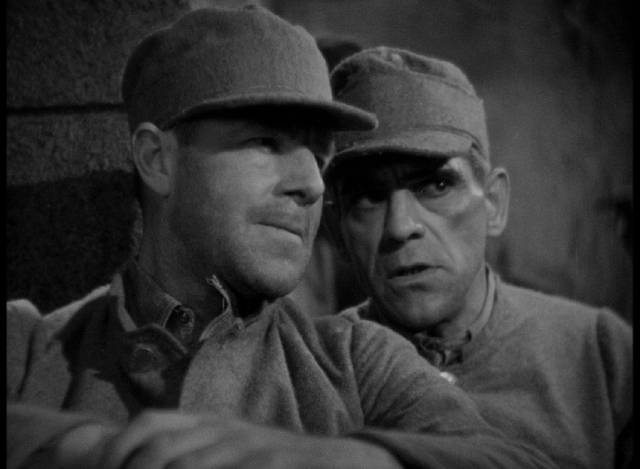
Behind the Mask (John Francis Dillon, 1932)
Although a bit disappointing in the moment, in retrospect there are things to enjoy in the other three films in the set. In John Francis Dillon’s Behind the Mask (1932), Karloff – still not yet quite a star – has a supporting role as convict Jim Henderson. Having struck up a relationship with fellow prisoner Quinn (Jack Holt), he declines to join in a break-out because his sentence is almost up; but he does provide Quinn with an introduction to the drug-dealing gang he belongs to. What he doesn’t know is that Quinn is actually federal agent Jack Hart, serving time to provide cover for his mission to identify the gang’s Mr. Big. Once outside and on the run, Hart makes his way to the home of Arnold (Claude King), a man working unwillingly for the gang. Hart eventually identifies himself to Arnold’s daughter Julie (Constance Cummings) and persuades her to help him save her father by exposing the crooks. Having made contact with the shady Dr. August Steiner (Edward Van Sloan), Hart’s cover is soon blown and the gang plan to kill him after he helps retrieve a shipment of drugs from a ship at sea. Naturally, the agent is smarter than they think and the ending inevitably sees the good guy triumphing, exposing Mr. Big (not a big surprise), and getting the girl. While a solid crime story, the movie has one odd touch – Dr. Steiner, for some reason, has a lab equipped with some of Kenneth Strickfaden’s patented electrical devices which, along with Van Sloan’s connection to Frankenstein and Dracula, provides the sole justification for labelling Behind the Mask a horror film.
*
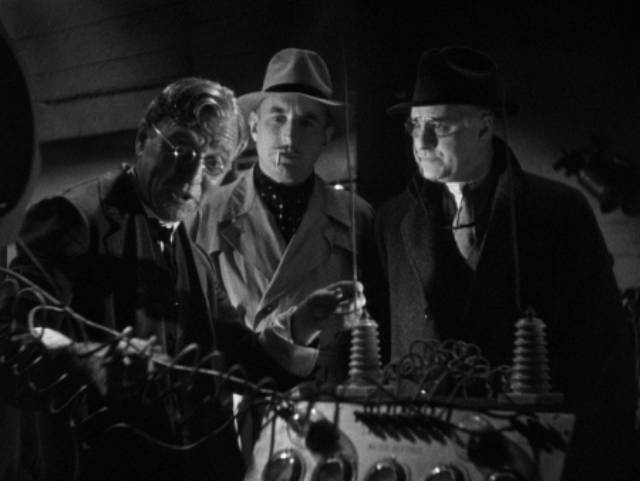
Air Hawks (Albert S. Rogell, 1935)
In Albert S. Rogell’s Air Hawks (1935), Ralph Bellamy plays Barry Eldon, a pilot who runs a small fleet of planes, whose company is vying for a major air mail contract. He’s the plucky little guy in competition with a ruthless corporation which is determined to eliminate its rivals. At first they try to buy his company, but he and his pilots are pioneering individualists who love to fly and hate big business. So, in order to make sure Barry doesn’t win the contract, they turn to sabotage to convince the government that the only reason he can keep his bid so low is by using sub-par equipment. And so Barry’s planes begin to crash and his pilots start to die. With the help of reporter Tiny Davis (Victor Killian), Barry eventually discovers that the crashes are being caused by a death ray developed by shady Eastern European scientist Professor Schulter (Edward Van Sloan again) – an interesting foreshadowing of evil Nazi scientists to come. The final stretch involves Barry putting himself in danger by flying towards the death ray and dropping bombs from the cockpit window, an exciting finale using elaborate models and miniatures.
*
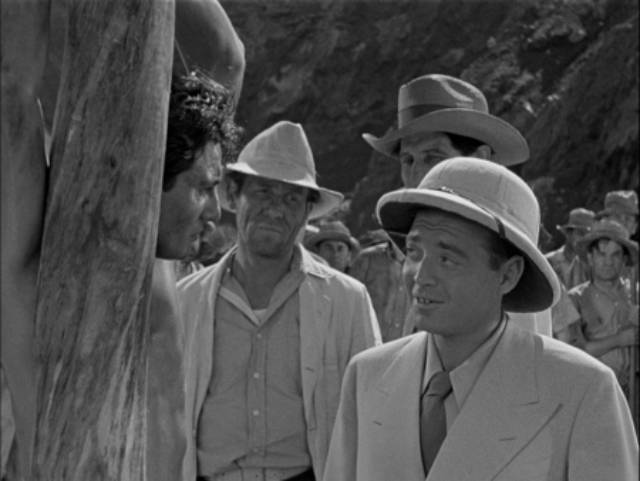
Island of Doomed Men (Charles Barton, 1940)
The main claim of Charles Barton’s Island of Doomed Men (1940) to be considered horror is the presence of Peter Lorre, even though his only previous horror movie was Karl Freund’s Mad Love (1935) – he had mostly had roles in thrillers and mysteries. Here, he plays the sadistic (and sexually insecure) Stephen Danel, whose public front as a philanthropic benefactor of former convicts trying to go straight conceals a diamond-mining operation on a private island which uses the paroled men as slave labour. Not satisfied with simply working these men to death, Danel enjoys torturing them, flogging them for the least infraction and casually killing them for minor annoyances. Additionally, he keeps his wife Lorraine (Rochelle Hudson) a virtual prisoner on the island, confined to a private compound in which she has to be careful not to trigger his rages. He knows that she despises him, but refuses to allow her to leave because she’s one of his possessions. Injected into this situation is an implausible plot in which undercover agent Mark Sheldon (Robert Wilcox) is framed for murder, sent to prison and, eventually, paroled on the recommendation of Danel, who already knows he’s a fed. Once on the island, Sheldon easily enlists Lorraine’s help in fomenting a revolt among the prisoners, a plan which is pretty transparent, with Danel aware of what he’s doing every step of the way. The setting and the sadistic villain are reminiscent of Erle C. Kenton’s Island of Lost Souls and Irving Pichel and Ernest B. Schoedsack’s The Most Dangerous Game (both 1932), but a private diamond mine is a rather mundane McGuffin – Lorre deserved something a bit more substantial, but he seems to relish Danel’s villainy and is the movie’s only real point of interest.
*
As always, Indicator presents these six movies (two per disk) in generally excellent transfers, though there are occasional signs of damage. Each film gets a commentary, and there are featurettes on Jack Holt, Peter Lorre and Burnett Guffey; an audio interview with Constance Cummings; a very brief clip of pilot Wiley Post (who has a cameo in Air Hawks) taking off for a trans-Atlantic flight in 1933; and a surprisingly gruesome Air Force training film from 1943 about the dangers of carelessness in handling a plane’s weapons. There’s also a 100-page book of new and archival writing about the films.
Comments